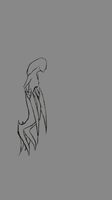Profile
Vieles Species Description
Taxonomy
| Kingdom | Animalia |
|---|---|
| Phylum | Chordata |
| Class | Vilesidae |
| Order | Vilesiformes |
| Family | Famemidae |
| Genus | Consanguineus |
| Species | Famem Consanguineus |
Morphology
Vieles possess a humanoid body plan characterized by two legs, two arms, and a non-segmented torso. Their skin is predominantly dark reddish-brown, with vibrant green markings around the appendages and black areas between the cranial lappet and the back of their legs. Notably, glowing green circles adorn the black areas on their legs, occasionally emitting a luminescent "blood" flow. When open, the cranial lappet also exhibits this remarkable blood flow, adding to their striking appearance.
Physiology
The physiological features of Famem Consanguineus are equally remarkable. Their skin is hardened and resilient, providing protection against environmental hazards within the meteor belt. Vieles possess long, scythe-like arms and digitigrade legs, with two root-like appendages serving as feet. This unique anatomical configuration enables them to move both bipedally and quadrupedally, enhancing their mobility and adaptability in their subterranean habitat.
Behavior and Social Structure
Vieles are highly social beings, exhibiting complex social interactions and a cooperative lifestyle. Observations suggest a collective consciousness or hivemind-like behavior, facilitating communication and the exchange of genetic information among individuals. They engage in communal activities such as foraging for protein-rich fruits from indigenous plant species and participating in territorial defense against intruders.
Ecology and Habitat
Vieles primarily inhabit caves and tunnels within the meteor belt ecosystem, utilizing these subterranean environments for shelter and nesting. They demonstrate a preference for areas rich in plant life, particularly species with bulbous, protein-rich fruits. As apex predators within their ecosystem, Vieles play a crucial role in regulating population dynamics and maintaining ecological balance through predation on smaller organisms.
Conclusion
Famem Consanguineus, or Vieles, represents a fascinating example of extraterrestrial life forms with unique adaptations and social dynamics. Further research into their biology, behavior, and ecological interactions promises to unveil additional insights into the complexities of Vieles society and its place within the broader context of the meteor belt ecosystem.


Comments